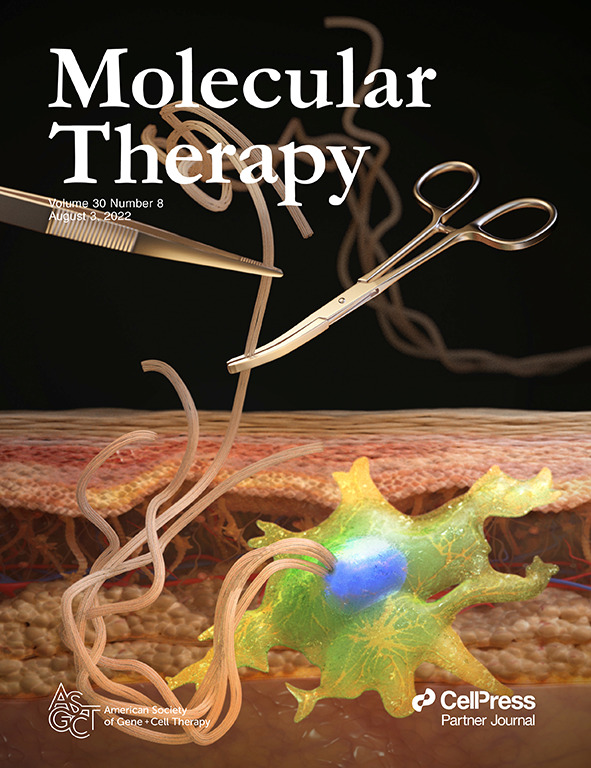The Vector
Volume 11, Issue 8: August 2022
Editorial Team
Karen Bulaklak, PhD – Editor, The Vector
Jon Brudvig, PhD – Associate Editor, The Vector
Inside This Issue
Leadership Message
Breaking Through
From Molecular Therapy
Society News
Career Center
Public Policy
Industry News
Leadership Message
Register at a Reduced Rate for ISSCR Symposium
 Hello ASGCT Members,
Hello ASGCT Members,
I hope you’re having a wonderful summer. As usual, we have plenty of events and new programming in the works. This month, though, I want to tell you a bit about a joint event we are hosting Sept. 21-23 with the International Society for Stem Cell Research (ISSCR).
For the second year, and the first time in person, we’ll welcome regenerative medicine experts to Madison, WI for Emerging Therapies at the Intersection of Genetic and Cellular Technologies. This international symposium will give attendees a look into the development of gene and cell therapies for diseases of the nervous, hematopoietic, and muscle systems, diabetes, metabolic diseases, and cancer. Speakers will discuss their own work on these therapies as well as new technologies shaping the future of the field. Our own ASGCT Past President, Don Kohn, MD, is a keynote speaker at the event. If you saw him speak at this year’s Annual Meeting, you know you won’t want to miss him!
As an ASGCT member, you’re eligible for discounted registration whether you attend in person or virtually. You’ll also have on-demand access for 30 days following the event. I encourage you to take advantage of these savings and register today! Connect with scientists and industry leaders in Madison or watch from wherever you like virtually.
Less than one week after this symposium, the fourth annual Policy Summit makes its triumphant return to Washington, D.C.! Over 1.5 days, we’ll hear about the latest updates on the regulatory, legislative, and payment policy side of the field from stakeholders at FDA and NIH, industry professionals, and more. Register to attend in person (limited space is available) or virtually to learn about some of the most hot-button policy issues.
I hope you’ll attend these events and enjoy the rest of your summer!
Sincerely,
Hans-Peter Kiem, MD, PhD
ASGCT President
Breaking Through
AAV capsid engineering identified two novel variants with improved in vivo tropism for cardiomyocytes
Rode L, Bär C, Groß S, Rossi A, Meumann N, Viereck J, Abbas N, Xiao K, Riedel I, Gietz A, Zimmer K, Odenthal M, Büning H, and Thum T
DOI: https://doi.org/10.1016/j.ymthe.2022.07.003
Summary by Karen Bulaklak, PhD
Recombinant AAV vectors are popular delivery vehicles in the field of gene therapy due to their versatility and high transduction efficiency in many different tissues. Still, preexisting immunity against AAV and off-target expression can pose safety concerns, which has spurred efforts to generate capsids that can escape immune detection and selectively transduce tissues of interest. In a recent report, Rode et al aimed to overcome such obstacles for cardiac-directed therapies by identifying novel capsids for targeting cardiomyocytes (CMCs).
For heart gene therapies, many groups have utilized highly cardiotropic serotypes such as AAV9 with great success, yet this comes at the cost of off-target expression in other tissues, such as the liver. To find a better capsid for the heart, Rode et al took a high throughput approach by designing a random library of peptides within a prominent protrusion of the AAV2 capsid (between asparagine 587 and arginine 588 of the VP1 subunit). This capsid library was injected into mice, and hearts and liver were later harvested to identify capsids that were enriched in the cardiomyocyte population and sufficiently detargeted from the liver. After three rounds of selection, they found three new variants: AAV2-THGTPAD, AAV2-NLPGSGD, and AAV2-LPSRPSL. AAV2-LPSRPSL in particular displayed the greatest CMC enrichment; however, this capsid was also prominent in the liver. Looking at the physical properties of the capsids, the group found that these variants were not dependent on the primary AAV2 receptor for entry into the cell, could likely uncoat more efficiently, and could also transduce human iPSC-CMCs. After injection into mice with cardiac hypertrophy (TAC), the novel capsids were just as abundant in the CMCs as AAV9. On the other hand, there were fewer vector genomes in the liver compared to AAV9, indicating that these capsids display greater liver detargeting. A similar pattern was observed in reporter expression, where the novel capsids showed comparable levels to AAV9 in cardiac cells, while liver expression was reduced. To explore questions of immunogenicity, neutralizing antibody experiments with mouse serum revealed a distinct immunogenicity profile for the new capsids compared to the parental AAV2. The group also investigated redosing with the new capsids but did not find any improvements in reporter expression when using orthogonal capsids. Finally, Rode et al tested these capsids in TAC mice, packaging therapeutic lcRNA H19. At a low dose, the novel capsids elicited significant improvements in several measures of cardiac function. This was accompanied by higher H19 copy numbers in the heart and lower copy numbers in the liver compared to AAV9. Since these engineered capsids were efficacious at a lower dose, this could improve safety for future cardiac gene therapies.
The work performed by Rode et al described here is just a snapshot of the enormous efforts currently underway in capsid engineering. Successful work like this provides hope that we may find the optimal vector for each therapeutic application that proves to be efficacious and safe for the benefit of patients.
From Molecular Therapy
_1.aspx?width=125&height=162)
Molecular Therapy impact factor reaches 12.9 in 2021
The impact factor of our flagship journal Molecular Therapy inreased to 12.9 in 2021–the highest value in its history! The increase represented a 12.6 percent jump for the journal from 2020 to 2021. Read Dr. Herzog's blog post.
Call for papers: Exploiting extracellular vesicles as therapeutic agents
The editors of the Molecular Therapy family of journals are pleased to announce a concomitant series of special issues across the journal family focused on the identification, characterization, and standardization of EV technology and the exploitation of the latter as therapeutic agents and biomarkers for the treatment of the gamut of human disease. Learn more.
Latest MT issues: Check out the most recent issues of these Molecular Therapy family journals:
Society News
Policy Summit In-Person Space Is Filling Up Fast
Want to attend the fourth annual Policy Summit in person? Register soon to secure your spot Sept. 26-27, as space at the J.W Marriott in Washington, D.C. is limited. Receive a discounted rate if you book your room by Aug. 23. You can also attend virtually; all attendees will have access to on-demand programming for 30 days. Learn about topics that inform policies impacting the field, like PDUFA reauthorization, diversity in clinical trials, accelerated approval, and more.
Attend a Free ProDev Café, Lunch & Learn This Month
There's still time to register for tomorrow's Professional Development Café, The ABCs of Starting Your Own Company. We're looking forward to welcoming speaker Matthew Hirsch, PhD, one of the 2022 Outstanding New Investigator Award winners. Then on Aug. 25, join us for our next Patient Education Lunch & Learn, Routes of Administration. Our speaker, Kimberly Goodspeed, MD, will discuss procedures, safety concerns, and limitations related to the application of different therapeutic delivery routes in humans.
Receive a Discount to Attend ASGCT-ISSCR Symposium
As an ASGCT Member, you can save at least $400 when you register for our joint international symposium with ISSCR. Our exciting program with will highlight the latest advancements in regenerative medicine at the intersection of genetic and cellular technologies. Check out the speakers here and register now!
Career Center
Are you looking for a job in the field of gene and cell therapy? Check out the new ASGCT Career Center for great opportunities with industry, government, and academic organizations. Sign up to receive alerts for open jobs in your area.
If you're from a recruiting institution, advertise in the Featured Jobs section to target the 4,000+ audience of The Vector.

Featured Jobs
Public Policy
Learn From Regulators at Next Month's Policy Summit
ASGCT has confirmed several speakers from FDA to discuss a number of hot topics in the gene and cell therapy space at this year’s Policy Summit. Join your colleagues and hear from regulators on issues including:
-
Diversity in Cell and Gene Therapy Development – featuring Asha Das, MD; FDA Office of Tissues and Advanced Therapies
-
PDUFA VII Reauthorization Process and Updates – featuring Wilson Bryan, MD; FDA Office of Tissues and Advanced Therapies
-
CMC Applications and Hurdles – featuring Zhaohui Ye, PhD; FDA Office of Tissues and Advanced Therapies
With a mix of roundtable discussions and formal presentations, the ASGCT Policy Summit will allow attendees to network and ask questions on these important and timely topics. You can view our online agenda for a full list of confirmed speakers and session topics, and be sure to register soon as in-person attendance is limited. There is also an online option.
How Your Policy & Advocacy Team Works for You
As the cell and gene therapy field continues to grow, your ASGCT Policy and Advocacy (P&A) team is finding new ways to support research, development, and commercialization of these therapies through public policy channels. The goal of ASGCT’s P&A department is to proactively inform legislators and regulators about gene and cell therapies, and to develop policy relationships that will help promote broad patient access to approved therapies.
At ASGCT, the P&A department works throughout the year to engage with decision makers to advocate for the interests of our members and support policy-focused member programming. In addition to programs like the annual Policy Summit and FDA Liaison Meeting, the P&A team works on multiple parallel tracks: submitting responses to FDA draft guidance and other government proposals; developing white papers on regulatory and access issues; meeting with decision makers at FDA, NIH, CMS, and on Capitol Hill to provide information on cell and gene therapies; tackling questions on responsible use frameworks for new technologies; and more.
With input from ASGCT’s academic and industry member experts, ASGCT advocates for regulatory and legislative structures that build a solid foundation for the future of genetic therapies. You provide the core science, data, and forward-looking perspectives on issues in the field; the P&A team works to communicate your needs and the needs of patients to decisionmakers. ASGCT believes it is critical to share our members’ voices and work to ensure that policy is science-driven, sustainable, and innovative – just like the therapies you work so hard to bring to patients.